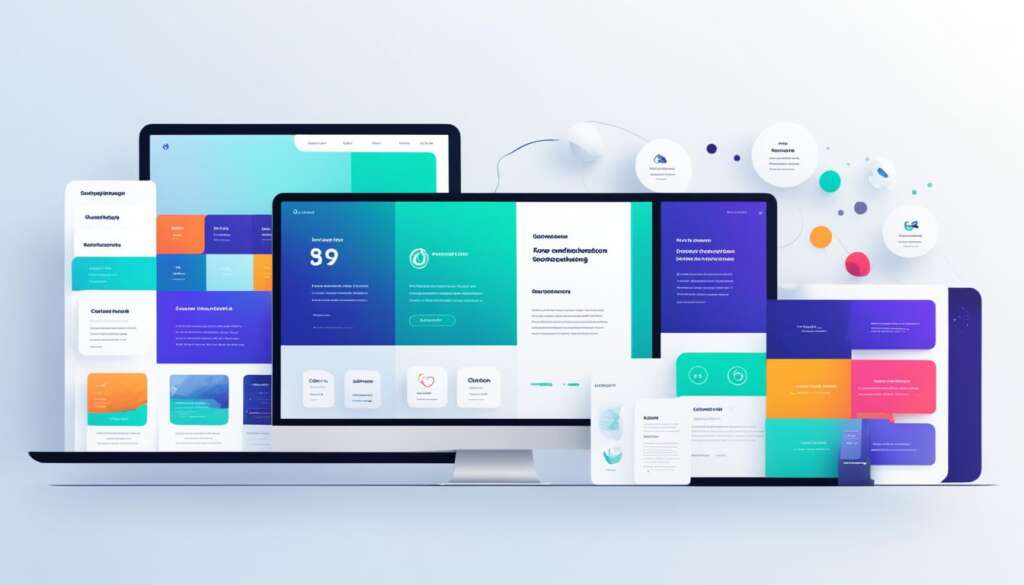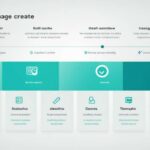Table of Contents
Welcome to our guide on building a UI/UX design portfolio that will make you stand out from the competition. As a designer, your portfolio is your calling card, showcasing your skills, creativity, and ability to solve complex design problems. It goes beyond just displaying your previous projects; it should captivate employers and potential clients, leaving a lasting impression.
So, what makes a great UI/UX design portfolio? How can you create a portfolio that truly reflects your abilities and catches the attention of employers? In this article, we’ll guide you through the process of developing a standout portfolio that highlights your expertise and sets you apart in the competitive field of UI/UX design.
Whether you’re a seasoned designer or just starting out, we’ll cover everything you need to know about creating a successful UI/UX design portfolio. From the purpose of a portfolio to what to include and how to showcase your skills effectively, we’ve got you covered.
Ready to make an impact and take your career to new heights? Let’s dive in and discover how to build a UI/UX design portfolio that will leave a lasting impression.
The Purpose of a UI/UX Design Portfolio
A well-crafted UI/UX design portfolio serves a crucial purpose in showcasing your best work and skills to potential employers and clients. It goes beyond being a mere collection of previous projects, acting as a powerful tool to validate your design expertise and secure job opportunities, whether in full-time employment or freelance work.
Unlike a mere art piece, the primary objective of a UI/UX design portfolio is to help you land a job by demonstrating your capabilities and suitability for the role. It enables hiring managers and recruiters to assess whether you possess the necessary design skills and problem-solving abilities required for the position.
“Your UI/UX design portfolio is your chance to make a lasting impression and showcase your unique design approach and skillset.” – Emily Thompson, Senior UX Designer
A well-constructed portfolio should aim to elevate your chances of securing a design job by effectively presenting your work experience, design process, and overall passion for the field. It should answer questions about your design capabilities, the type of work you specialize in, your design process, and your ability to address complex design problems.
By incorporating an attractive landing page, comprehensive case studies, and an “About Me” section that highlights your background and experience, your portfolio becomes a comprehensive representation of your skills and qualities as a UI/UX designer.
To further emphasize the purpose of a UI/UX design portfolio, it’s essential to understand that it serves as a window into your abilities and acts as a potent marketing tool. Prospective employers and clients rely on portfolios to assess your design talent, compatibility with their organization, and potential fit for specific projects.
Remember, your UI/UX design portfolio is your opportunity to impress and stand out from the competition. It’s a testament to your capabilities and acts as a gateway to your dream job.
What Makes a Great UI/UX Portfolio
Creating a great UI/UX portfolio is vital to showcase your skills and attract the attention of hiring managers and potential clients. A well-crafted portfolio should not only demonstrate the type of work you do but also highlight your ability to create user-friendly designs. It should reflect your passion for design and exhibit the necessary experience for the role. Moreover, including a diverse range of design projects in your portfolio is crucial for presenting your versatility and skills.
One of the key aspects of a great UI/UX portfolio is its ability to clearly communicate the value you bring as a designer. By showcasing your best work, you can effectively demonstrate your design process and problem-solving abilities. This enables potential clients to understand how you approach projects and the thinking behind your design decisions. Through well-presented case studies, you can guide viewers through your design rationale, showcasing your expertise in creating intuitive and user-friendly experiences.
Remember that your UI/UX portfolio is a representation of your unique style and creative flair. It should capture your passion for design and leave a lasting impression on viewers. Consider using visual elements, such as images and videos, to enhance your case studies and engage the viewer. By incorporating your personal touch and injecting your personality into your portfolio, you can create a memorable experience for those reviewing your work.
Building a great UI/UX portfolio requires careful thought and curation. It should be a reflection of your skills, professionalism, and dedication to your craft.
When selecting projects to include in your portfolio, aim for variety. Showcasing a range of design projects will not only highlight your adaptability but also demonstrate your ability to work on different platforms, industries, and user needs. This diversity can make your portfolio more appealing to potential clients, as they can see your versatility and problem-solving skills in action.
Ultimately, a great UI/UX portfolio distinguishes you from other designers by showcasing your past work, skills, and passion. It should provide a clear picture of your abilities and give potential clients the confidence that you are the right designer for their needs. By investing time and effort into creating a compelling portfolio, you can significantly increase your chances of landing new opportunities.
https://www.youtube.com/watch?v=uC1VK4ktsFc
Key Points:
- Create a portfolio that clearly showcases the type of work you do and your ability to create user-friendly designs.
- Demonstrate your design process and problem-solving skills through well-crafted case studies.
- Inject your personality and unique style into your portfolio to make a lasting impression.
- Include a variety of design projects to highlight your adaptability and versatility.
- Invest time and effort into creating a compelling portfolio to increase your chances of landing new opportunities.
What to Include in Your UI/UX Portfolio
When creating your UI/UX portfolio, it’s important to include the right elements to showcase your skills and impress potential clients or employers. Here are some key components to consider:
An Attractive Landing Page
Your portfolio’s landing page is the first impression that visitors will have. Make it visually appealing and user-friendly, providing a glimpse into your design aesthetic and expertise. Consider including thumbnail previews of your projects to grab attention.
Project Descriptions
Each project in your portfolio should have a concise yet informative description. This will help recruiters quickly find relevant information and understand the scope of your work. Highlight the key features and outcomes of each project to demonstrate your problem-solving abilities.
Case Studies
Case studies are a powerful way to showcase your design process and dive deep into your role in each project. Use visuals such as images, videos, or recordings to enhance the storytelling aspect. Discuss the challenges faced, your approach to overcoming them, and the impact of your design solutions.
About Me Section
Include an “About Me” section or work history to provide more context about your background, education, and relevant experience. This helps potential clients or employers understand your journey as a designer and makes a personal connection.
Testimonials and Social Media
If you have received positive feedback from previous clients or colleagues, include testimonials in your portfolio to build trust and credibility. Additionally, consider adding links to your social media profiles to showcase your active engagement in the design community.
Showcase Your Skills
Make sure to showcase a variety of skills that are relevant to UI/UX design. This could include user research, user flows, wireframing, mockups, persona development, visual design, information architecture, agile design, and collaboration. Highlighting these skills will give potential clients or employers an idea of your capabilities.
| Components to Include in Your UI/UX Portfolio | Description |
|---|---|
| An Attractive Landing Page | The first impression of your portfolio, featuring thumbnail previews of projects. |
| Project Descriptions | Brief yet informative descriptions for each project, highlighting key features and outcomes. |
| Case Studies | In-depth exploration of your design process, challenges faced, and the impact of your solutions. |
| About Me Section | Background information, education, and relevant experience to provide context. |
| Testimonials and Social Media | Include positive testimonials and links to your social media profiles for credibility. |
| Showcase Your Skills | Highlight a variety of relevant UI/UX design skills to demonstrate your capabilities. |
What If You Don’t Have UI/UX Design Experience
Lack of formal UI/UX design experience shouldn’t discourage you from creating a portfolio. There are ways to build a portfolio from scratch, even without prior experience in the field. Here are some strategies you can employ:
- Join a UX Course: Enrolling in a UX course can provide you with valuable knowledge and practical skills. It will help you understand the principles of UI/UX design and gain hands-on experience in creating user-centered designs. This can be a great starting point to showcase your learning and abilities in your portfolio.
- Work on Personal Projects: Take on personal projects to build your design skills and create a body of work. You can identify areas or problems that interest you and design solutions for them. These projects will demonstrate your creativity, problem-solving abilities, and your ability to apply design principles to real-world scenarios.
- Volunteer: Offer your design services to non-profit organizations or local businesses. This will allow you to gain practical experience by working on real projects while contributing to a good cause. Volunteering can also help you network and make valuable connections in the design industry.
- Leverage Past Experience: If you’re switching careers and don’t have direct UI/UX design experience, you can still leverage your past experience in other fields. Identify transferable skills such as problem-solving, communication, and attention to detail, and frame them in the context of UX design. Highlight how these skills can benefit your future career in UI/UX design.
- Learn Basic Design Tools and Principles: Familiarize yourself with popular design tools such as Adobe XD, Sketch, or Figma. Learn the basics of user research, wireframing, prototyping, and visual design. By acquiring these fundamental skills, you can overcome the lack of formal experience and demonstrate your proficiency in UI/UX design.
Note: Remember, employers value passion, creativity, and problem-solving skills just as much as formal experience. Your unique perspective and fresh ideas can make an impression and set you apart from candidates with more conventional backgrounds.
With determination and the right approach, you can create an impressive UI/UX design portfolio that showcases your potential and opens doors to exciting opportunities.
Example of Projects in a UI/UX Design Portfolio
Suppose you don’t have any formal UI/UX design experience but have worked on personal projects and volunteered for a non-profit organization. Your portfolio might include projects such as:
| Project | Description |
|---|---|
| Redesigning Non-Profit Website | A complete redesign of a non-profit organization’s website to improve user experience, streamline donations, and increase engagement. The project involved conducting user research, creating wireframes, and implementing an intuitive and visually appealing design. |
| Mobile App for Event Management | A mobile app designed to simplify event management and enhance attendee experience. The project included user flow analysis, wireframing, prototyping, and iterative design improvements based on user feedback. |
| E-commerce Website Redesign | A redesign of an existing e-commerce website focused on optimizing the user journey, improving product discovery, and enhancing the checkout process. The project encompassed user research, creating interactive prototypes, and collaborating with developers to implement the new design. |
These projects demonstrate your ability to solve design problems, understand user needs, and create visually appealing and user-friendly interfaces.
Remember, a great UI/UX design portfolio isn’t just about the number of years of experience. It’s about showcasing your skills, passion, and ability to create meaningful experiences for users. So don’t let the lack of formal UI/UX design experience hold you back.
Tips for Creating a Successful UX Portfolio
When it comes to creating a successful UX portfolio, there are several key tips to keep in mind. These tips will help you showcase your skills, engage potential employers, and stand out from the competition.
Choose Relevant Case Studies
One of the most important aspects of a UX portfolio is the selection of case studies. It’s crucial to choose case studies that are relevant to the job you’re applying for. This demonstrates your ability to tackle specific challenges and showcases your expertise in the desired field. Whether it’s designing an e-commerce website or improving user engagement in a mobile app, be sure to highlight projects that align with the job requirements.
Tell a Compelling Story
Another way to make your UX portfolio stand out is by telling a compelling story through your case studies. Don’t just present the final product; take the reader on a journey from the initial problem to the final solution. Describe the research, ideation, iterations, and user testing that led to your design decisions. By sharing your design process and thoughtfulness, you engage and connect with the viewer, showcasing your problem-solving abilities.
Enhance with Visual Elements
Visual elements are powerful tools that can enhance your case studies and make your portfolio more engaging. Consider incorporating images, videos, or recordings that demonstrate the functionality and interaction of your designs. These visuals provide a better understanding of your UX solutions and create a more immersive experience for the viewer.
Highlight Critical Project Elements
In your case studies, it’s important to highlight the most critical parts of your projects. Whether it’s a unique design feature, an innovative interaction, or a user-centric solution, draw attention to these key elements through visuals and concise descriptions. This helps potential employers quickly grasp the impact and value of your work.
Show Business Impact
Employers want to see the impact and success of your UX projects. Include business details and metrics in your case studies to demonstrate how your designs have achieved results. This could include improved conversion rates, increased user satisfaction, or measurable business growth. Showing the tangible outcomes of your work helps employers understand the value you can bring to their organization.
Showcase Your Personality and Brand
Don’t be afraid to infuse your personality into your UX portfolio. It’s essential to be authentic and consistent with your personal brand. Share your unique perspectives, approach, and design philosophy. This not only gives employers a glimpse into who you are as a designer but also helps you differentiate yourself from other candidates.
| Tips for Creating a Successful UX Portfolio |
|---|
| Choose relevant case studies |
| Tell a compelling story |
| Enhance with visual elements |
| Highlight critical project elements |
| Show business impact |
| Showcase your personality and brand |
By following these tips, you can create a successful UX portfolio that effectively showcases your skills, experience, and unique design approach. Remember to tailor your portfolio to the specific job you’re applying for and use visuals, storytelling, and metrics to make a lasting impression on potential employers. Good luck!
Conclusion
Creating a UI/UX design portfolio is essential for showcasing your skills and getting hired. It serves as a powerful tool to demonstrate your design process, problem-solving abilities, and passion for the field. By including an attractive landing page, well-crafted case studies, and an informative “About Me” section, you can effectively communicate your expertise to potential employers and clients.
When building your portfolio, it’s crucial to tailor it to the specific job or client you are targeting. By showcasing your relevant skills and experiences, you can make a strong impression and stand out from the competition. Additionally, using your portfolio as a platform to tell a compelling story about your projects and design journey will captivate viewers and leave a lasting impact.
Don’t shy away from injecting your personality into your portfolio. Creating a unique personal brand that reflects your style and values can help you make a memorable impression on employers and clients. Remember, a well-crafted UI/UX design portfolio is your opportunity to impress and demonstrate your capabilities, so take the time to make it visually appealing and informative.
With a compelling UI/UX design portfolio, you can confidently showcase your skills, attract potential clients, and secure your dream job in the industry. So go ahead, start crafting your portfolio today and unlock new opportunities in the world of UI/UX design.
FAQ
Why is a UI/UX design portfolio important?
A UI/UX design portfolio is essential for showcasing your skills and abilities as a designer. It goes beyond just displaying previous clients and projects and helps hiring managers and potential clients understand your design skills and problem-solving abilities.
What should a great UI/UX design portfolio include?
A great UI/UX design portfolio should include an attractive landing page, case studies of your best work, and an “About Me” section or work history. It should answer questions about the type of work you do, your design process, problem-solving skills, and passion. It should also showcase your ability to create user-friendly designs.
How can I build a UI/UX design portfolio if I don’t have formal experience?
Lack of formal UI/UX design experience should not discourage you from creating a portfolio. You can build a portfolio from scratch by joining a UX course, working on personal projects, or volunteering. You can also leverage your past experience in other fields and frame it in UX terms. By learning basic design tools and principles, you can overcome the lack of formal experience.
What should I include in my case studies?
In your case studies, you should choose relevant projects that align with the job you are applying for. Tell a story that engages and connects with the viewer, using visual elements such as images, videos, or recordings to enhance your case studies. Highlight the most critical parts of your projects and add business details and metrics to show the impact and success.
How can I create a successful UI/UX portfolio?
To create a successful UI/UX portfolio, tailor it to the specific job you are applying for. Showcase your skills and tell a compelling story that sets you apart from other candidates. Inject your personality and be consistent with your personal brand. With a well-crafted portfolio, you can impress potential clients and land your dream job.













